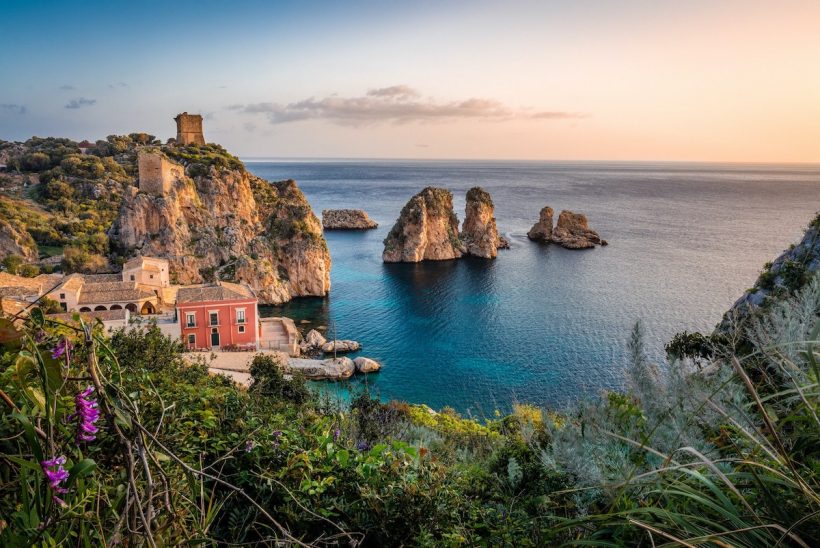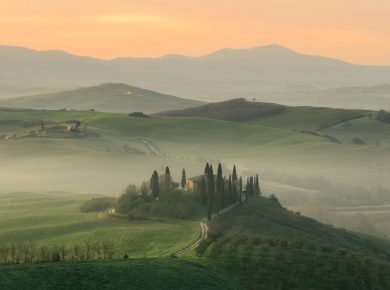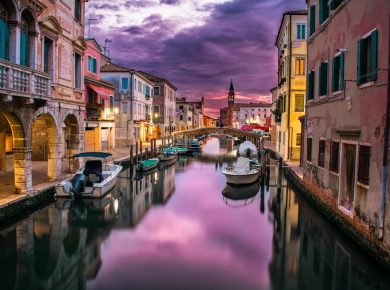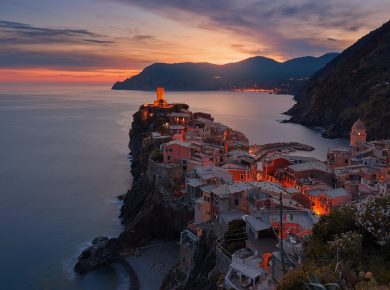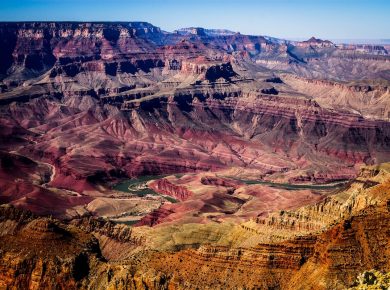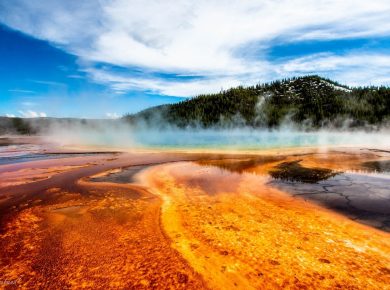Few destinations in Europe can rival the beauty of Sicily. With its stunning coastline, Mediterranean climate, and rich cultural heritage, the island has something to offer visitors all year round. Whether you’re looking to relax on the beach, explore ancient ruins, or sample delicious regional cuisine, Sicily is sure to exceed your expectations. And with so much to see and do, you’ll never be short of things to keep you entertained.
The largest island in Italy, Sicily is unsurprisingly also one of the most popular tourist destinations in the country. From the lively capital of Palermo to the beautiful Baroque towns and villages inland, there is much to explore on this enchanting island. This island has long seduced travelers with its many cultural treasure and natural wonders.
The best months to visit Sicily are March through June and October when the tourists crowds are smaller and the weather is milder. The days leading up to Easter are full of festivals, and worth planning around. The hottest months are July and August and the beaches and resorts can be crowded. September is the busiest and most expensive month.
First of all, the island is home to some of the most stunning scenery in all of Europe. From the snow-capped mountains of the north to the sun-drenched beaches of the south, Sicily offers a wide variety of landscapes to explore. In addition, the island is steeped in history and culture.
From the ancient Greek ruins of Agrigento to the medieval castle town of Cefalu, there is much to see and learn about Sicily’s rich past. And of course, no visit to Sicily would be complete without enjoying some of the delicious food and wine for which the island is renowned.
Sicily has been inhabited for thousands of years, and you can still see evidence of its rich history all over the island. In Palermo, the capital city, you can find imposing churches and cathedrals as well as colorful markets selling everything from fresh produce to souvenirs. Nearby Mount Etna is one of the most active volcanoes in the world and offers hikers some spectacular views. Other popular tourist destinations include Syracuse with its ancient Greek ruins and Taormina with its dramatic cliffs overlooking the Mediterranean Sea.
As with anywhere in Italy, it’s important to be aware of the weather in Sicily before you visit. Overall, the island experiences long, hot summers and relatively mild winters making it a great destination for visitors all year round.
However, you should note that the weather in Sicily can vary a great deal depending on where you are on the island. The coastal areas have a Mediterranean climate, with hot, dry summers and mild winters. However, the interior of the island can be much cooler, with temperatures sometimes dropping below freezing in winter.
The best time to visit really depends on what you want to do. If you’re interested in sightseeing or looking for cultural exploration, Sicily is equally rewarding in spring and autumn, when the weather is mild and the countryside is ablaze with wildflowers or autumnal colors.
Travelers who don’t mind a little cold or a little rain can enjoy discounted rates in winter when the island’s many attractions are a little quieter. And for those who want to go skiing or visit other parts of Italy that are further north, then winter is definitely a better time to go.
Of course, if you’re looking for a relaxing beach holiday, the summer months are perfect, when the beaches are packed with sun-seekers and the islands are alive with a buzzing nightlife. This island offers something for everyone, no matter what time of year it is. So no matter when you choose to visit, Sicily is sure to charm you with its mixture of history, culture, and natural beauty.
Table of Contents
Average Temperature In Sicily
Throughout the year, the temperatures in Sicily vary from 50°F to 85°F, rarely dropping below 44°F or rising above 91°F. Summers are warm, muggy, and dry, with the hot season lasting for three months from June 20 to September 20.
Although the temperature can vary widely depending on the location, in general, Sicily is a very warm and pleasant place to be during the summer months. The hottest month of the year is August with an average high of 85°F and low of 75°F. However, the weather is still enjoyable with plenty of beaches and activities to enjoy.
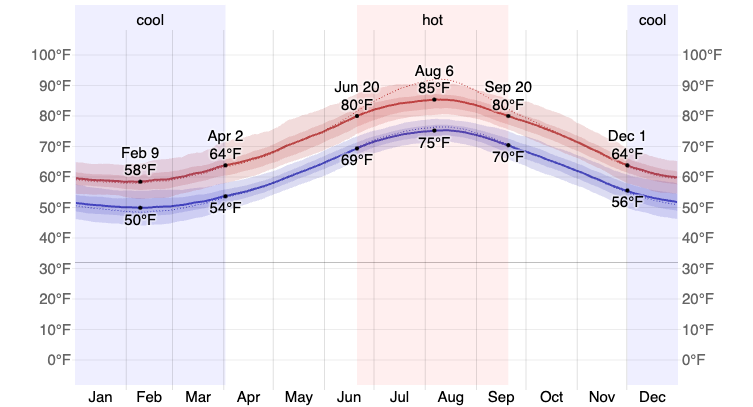
Winters in Sicily are long, cool, and wet. The cool season lasts for four months, from December to April, with an average daily high temperature below sixty-four degrees Fahrenheit. The coldest month of the year is February, with an average low of fifty degrees Fahrenheit and a high of fifty-nine degrees Fahrenheit.
Daily Chance Of Precipitation In Sicily
Sicily is a beautiful and unique island located in the Mediterranean Sea. The island’s average annual rainfall is a little more than 23 inches per year, which means that it is classified as a dry climate.
Despite this, Sicily is lush and green, due in part to the misty weather that often blankets the island. The misty weather is also responsible for the creation of spectacular waterfalls, such as the Alcantara Gorges, which are located on the northeastern side of Sicily.
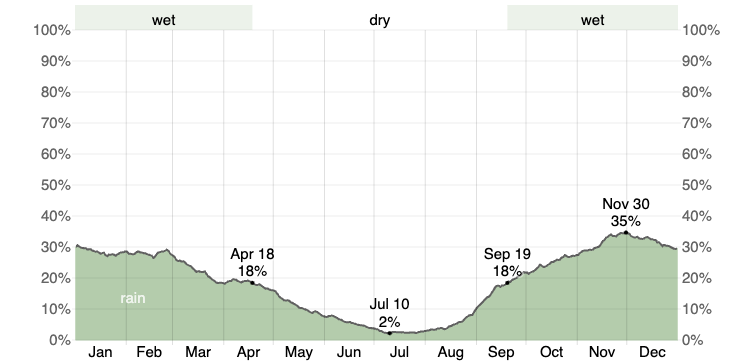
The chance of wet days with at least 0.04 inches of precipitation in Sicily varies significantly throughout the year. The wet season lasts 7 months, from September 19 to April 18. In September and October, the chance of a wet day is around 30%. This chance increases to around 50% in November and December. December is the wettest month with typically 9.8 days with at least 0.04 inches of precipitation.
The drier season, which is April through September, lasts for five months and the month with the fewest wet days is July. On average, there are only .8 days in July with at least 0.04 inches of precipitation.
Humidity Comfort Levels In Sicily
The weather in Sicily is highly variable, with temperatures ranging from hot and humid summers to cold and windy winters. The humidity also varies greatly, with the humid season starting in late spring and lasting until early autumn.
This can be quite uncomfortable for some visitors, as the humidity can make the air feel thick and muggy. However, for those who are used to it, the humidity can be quite refreshing and provide a level of comfort not found in other parts of the world.
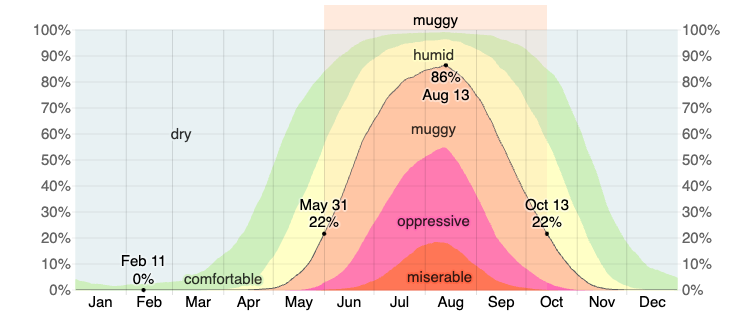
The muggy period of the year generally lasts from May to October, with August being the muggiest month. During this time, it can be quite uncomfortable to be outside due to the high levels of humidity.
The average humidity during July, the least humid month, is 64%. This makes the summer months a good time to visit if you are looking for less humidity. However, keep in mind that there is still some humidity during these months and the temperatures can be quite hot.
Best Time Of Year To Sicily For Great Weather
If you’re looking for great weather, the best time of year to visit Sicily is from March through June or in October. These months have fewer crowds and the weather during these months is typically mild, sunny, and pleasant. There are also lots of festivals during this time, so you’ll be able to enjoy the local culture.
If you’re a sun seeker, summertime is the perfect time to enjoy the heat and the sun in Sicily. The days are long and bright, and the weather is just perfect for spending time outdoors. Whether you’re looking to relax at the beach or take advantage of all the activities that Sicily has to offer, July and August are great months, especially at popular beaches and resorts.
However, summertime in Sicily is also very crowded. September often sees the most crowds. If you’re looking for some peace and quiet, you may want to avoid the peak season.
Best Time Of Year To Visit Sicily For Low Prices
The high season on the island is from July to September, with September being the busiest and most expensive month. During this time, you can expect to find crowded beaches, restaurants, and attractions.
If you’re looking for a more relaxed and affordable experience, consider visiting Sicily during the low season. The low season is from November to February, and while the temperatures can be cooler, it’s a great time to visit if you’re looking for lower prices and fewer crowds.
Sicily can be quite chilly in the winter, so make sure to pack warm clothes! You may even see snow at the higher altitudes. If you are prepared for the cooler temperatures, then Sicily can be a great place to visit in the winter months. The scenery is still absolutely beautiful, the food is still delicious, and the culture is still rich.
In fact, many people believe that the low season offers a more authentic Italian experience, as there are fewer tourists around and locals are more likely to be relaxed and welcoming.
Best Months To Travel To Sicily
When most people think of Sicily, they think of the intense heat and sun of the summer. However, what many people don’t know is that Sicily is an incredibly diverse and beautiful island with something to offer visitors no matter what time of year they choose to visit.
Summer is the perfect time to get out of the cities and explore traditional fishing villages, relax on stunning beaches, and swim in the turquoise water. Sicily is a beautiful island that is known for its stunning coastline, magnificent architecture, delicious food, and rich culture.
Most people visit Sicily during the summer months because the weather is warm and sunny and there are plenty of things to do. The island is home to some of the most beautiful beaches in Europe, and the water is crystal clear. You can explore ancient ruins, go wine tasting, or take a cooking class. There are also plenty of outdoor activities available, such as hiking, biking, and windsurfing.
Autumn is one of the most beautiful times of year to visit Sicily. Autumn is the time of the olive harvest and you may spot a few locals raking olives from trees as you wander through the villages and countryside.
You are sure to fall in love with the flavors of the local seafood pasta, pizza, gelato, arancini, and other delicious treats. Fall is also a great time to enjoy the unique Baroque architecture and colorful villages of the region. The moderate temperatures mean you won’t overheat while exploring all that Sicily has to offer.
During winter, the temperatures are milder than in summer, and the crowds of tourists have died down a bit, making it a great time to explore all that the island has to offer. There are so many things to see and do in Sicily during winter – from skiing on Mt. Etna to tasting the local delicacies such as sea urchins during their harvest season in February.
One of the best things about winter travel is the relaxed pace it brings. You can take your time to enjoy all that each destination has to offer without feeling rushed. Additionally, since there are fewer tourists around during winter, it can be easier to get to know the locals on a personal basis. This can lead to some unforgettable experiences and memories.
Sicily is also home to some of the most amazing springtime landscapes in the world. In the spring, Sicily is brimming with vibrant hues of cherry blossoms and almond trees. Ripening citrus fruit add to the colorful landscape, providing a delicious aroma in the air.
In spring, the temperatures are still pleasantly warm and the island is not as crowded as it is in the summer. This makes it the perfect time to visit all of the historic sites and take in all of the beautiful scenery. The flowers are blooming, the birds are singing, and the olive trees are starting to turn green- it’s a true paradise.
So if you’re looking for a well-rounded vacation that includes some history and culture as well as beautiful scenery, spring is definitely the best time of year to visit Sicily.
